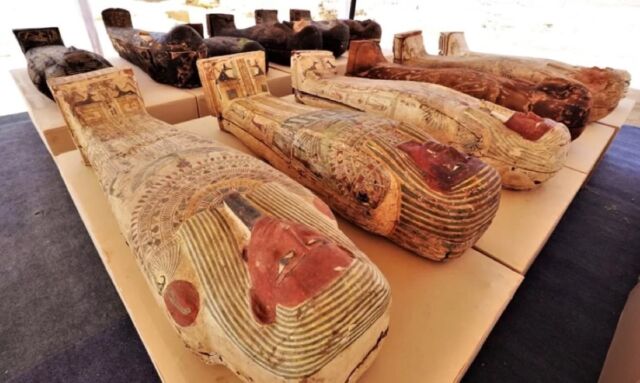
Public domain
Archaeologists have confirmed that a papyrus scroll discovered at the Saqquara necropolis site near Cairo last year does indeed contain texts from the Egyptian Book of the Dead—the first time a complete papyrus has been found in a century, according to Mostafa Waziri, secretary-general of the Supreme Council of Antiquities in Egypt. The scroll has been dubbed the “Waziri papyrus.” It is currently being translated into Arabic.
Fans of the 1999 film The Mummy know that the Egyptian Book of the Dead plays a key role in bringing the cursed high priest Imhotep back to terrorize the living. The reality is naturally quite different: notably, there is not one magical copy of the Book of the Dead, as depicted in the film; there were many versions over the centuries, all unique, with the choice of spells often tailored to the specific needs of deceased royals and (later) high-ranking members of Egyptian society.
These “books” were actually collections of funerary texts and spells to help the deceased on their journey through the underworld (Duat)—not to bring people back from the dead—and they are not holy texts like the Bible or Qur-an. They were originally painted onto objects or written on the walls of burial chambers. Over time, illustrations were added and spells were also inscribed on the interior of coffins or the linen shrouds used to wrap the deceased.

Nick Brundle Photography/Getty Images
One of the most famous spells is the “Weighing of the Heart” (designated 125 by scholars), dating to around 1475 BCE, by which time copies of the Book of the Dead were commonly written on papyrus. Anubis would lead the deceased before Osiris, where they would swear they had not committed any of 42 listed “sins,” and their heart was weighed on a pair of scales against a feather to determine if they were worthy of a place in the afterlife. (Those who watched Moon Knight will remember a version of this ceremony depicted in one of the later episodes, conducted by the hippo-headed Egyptian goddess of childbirth and fertility, Taweret.) Of the 192 spells currently known—no one manuscript contains them all—there are several protective spells to guard against the damage or loss of the heart, and in one case (30b) imploring the heart not to “betray” its owner during the weighing ritual by “telling lies in the presence of the god.”
Copies of the Book of the Dead were made to order by scribes, and the scrolls could be as short as 1 meter (3.2 feet) and as long as 40 meters (about 131 feet). People knew of the existence of such scrolls in the Middle Ages, and assumed that they were religious in nature because they were found in tombs. Karl Richard Lepsius coined the name Book of the Dead in 1842 after translating one such text. The best known example to date is the Papyrus of Ani, discovered in luxor in 1888 and now housed in the British Museum. But such finds are increasingly rare.

Ministry of Tourism and Antiquities
The Saqqara necropolis served the ancient Egyptian capital of Memphis, and boasts numerous pyramids, including the Step pyramid of Djoser, whose design and construction is usually attributed to Imhotep, chancellor to the Pharoah Djoser (and later immortalized as the monster in The Mummy). Saqqara was named a World Heritage Site by UNESCO in 1979, although looters during the 2011 Egyptian protests broke into store rooms and caused some damage to the site that year. Over the years, archaeologists have unearthed many tombs, artifacts, and mummies while excavating the site: a rare gilded burial mask and several dozen caches of mummies in 2018, for instance, or statues of various gods and a number of completely sealed sarcophagi in 2020.
In March 2022, archaeologists discovered five 4000-year-old tombs, recovering 250 painted wooden sarcophagi containing complete mummies and 150 statuettes of various gods at the site’s Cemetery of Ancient Animals. There was also a collection of cosmetics, bronze vessels, and a sistrum (percussive musical instrument). One of the sarcophagi also contained a papyrus scroll they believed measured about 9 meters (29.5 feet) and contained a chapter of the Book of the Dead written in hieroglyphics. It was sent to the laboratory of the Egyptian Museum in Cairo for further study.
Once the papyrus was fully restored, it actually measured 16 meters (about 52.5 feet). And scholars have now confirmed that the scroll does indeed contain spells from the Book of the Dead. According to Waziri, the papyrus will be presented at the opening of the Grand Egyptian Museum in Cairo sometime this year.
No harm ever came from reading a book… right? Classic scene from 1999’s The Mummy.








